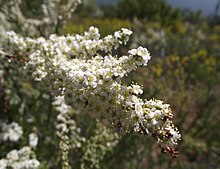

| Adenostoma | |
|---|---|

| |
| Adenostoma fasciculatum in flower | |
| Scientific classification | |
| Kingdom: | Plantae |
| Clade: | Tracheophytes |
| Clade: | Angiosperms |
| Clade: | Eudicots |
| Clade: | Rosids |
| Order: | Rosales |
| Family: | Rosaceae |
| Subfamily: | Amygdaloideae |
| Tribe: | Sorbarieae |
| Genus: | Adenostoma Hook. & Arn. |
Adenostoma is a genus of shrubs in the Rose family (Rosaceae) containing only two species, chamise (Adenostoma fasciculatum) and redshanks (Adenostoma sparsifolium). Both are native to the Californias.
The plants grow in a habit of shrubs to small trees, and the stem is more or less resinous.[1] Both species in this genus feature stiff, linear leaves arranged alternately or in clusters along stems with shredding bark. Flowers form on a panicle, are cream to white and, as in all members of the rose family, have hypanthia.[2] The fruit is an achene. Chromosome number is 2n = 18.[1]
Both species are native to coastal California and Baja California. Adenostoma fasciculatum is also native to California in the Sierra Nevada.[2] They are found in plant communities and sub-ecoregions of the California chaparral and woodlands ecoregion.
Phylogenetic analysis places Adenostoma closest to Chamaebatiaria and Sorbaria, and suggests tentative placement in the subfamily Spiraeoideae, tribe Sorbarieae.[3] The name Adenostoma comes from Greek, meaning "glandular mouth," referring to the hypanthium ring gland.[1]
| Adenostoma |
|
|---|---|
| Authority control databases: National |
|
|---|
This Amygdaloideae article is a stub. You can help Wikipedia by expanding it. |